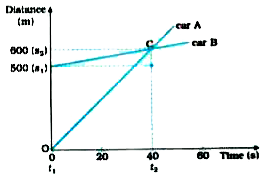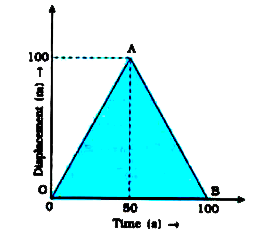Complete Solutions to ADDITIONAL NUMERICALS FOR PRACTICE of chapter MOTION of Class 9 book with complete answers and questions
| Class 9 | PHYSICS |
| Chapter | MOTION |
| KUMAR PRAKASHAN | ADDITIONAL NUMERICALS FOR PRACTICE |
| Number Of Questions | 48 |
| Academic Year | 2023-24 |
A person completes 5 rounds (revolutions) on a circular path of radius 50 m. Find out the distance travelled by that person and magnitude (value) of displacement.
02:25View SolutionThe distance between Ahmedabad and Vadodara is 100 km. A scooterist travels at the average speed of `50 km h^(-1).` If he travels first 60 km at a uniform speed of `45 kmh^(-1),` what will be his speed for the remaining distance ?
04:20View SolutionThe speed of the scooter moving with uniform acceleration of `4 m s^(-2)` becomes `20 ms^(-1)` at a certain time. What will be the speed of the scooter, when it has covered a distance of 112 m after that time?
01:49View SolutionThe velocity of a particle performing motion with uniform acceleration on a linear path, at position 'x' is 'v' and `v = sqrt (196-16x),` where x is in metre. What would be the acceleration of this particle? Take initial velocity of particle = 14 `m s^(-1)`
02:07View SolutionA person takes observations from odometer of his own motorcar while starting journey as well as after 40 min of his journey, which are found as 1046 km and 1096 km respectively. What would be the average speed of the motorcar?
01:43View SolutionA train was moving at the rate of 36 km/h. When brakes are applied to a train running on a straight line, it stops after covering 200 m distance. What would be the retardation produced in the train ?
02:38View SolutionA graph of velocity versus time (v - t) for a moving particle on linear path is shown in figure. What would be the displacement of the particle in first 30 s?
 03:14View Solution
03:14View SolutionAn object is allowed to fall freely from the top of a 150 m high tower. At the same time another object is allowed to fall freely from the top of a 100 m high tower. If the acceleration of both the free falling objects is same, then find the difference between their heights after 2 s from their motion. How does the difference of their heights change with the time?
02:43View SolutionTwo stones are thrown vertically upward simultaneously with velocity `u _(1) and u _(2)` Prove that ratio of their maximum height attained is `u _(1) ^(2) : u _(2) ^(2).`(Take -g for acceleration in upward direction and +g for acceleration in downward direction.)
02:21View SolutionAn object is moving on a linear path in definite direction with initial velocity 'u' with constant acceleration. Prove that the distance travelled by it during 'n'th second is`u + (a)/(2) (2n -1).`
01:52View SolutionA stationary object, when starts motion, covers 20 m distance in first 28 and 160 m in next 4 second. Calculate the velocity at the end 7 second from the beginning of the motion.
02:11View SolutionUse the data given in the following table and draw the displacement-time graph for the object :

Using the graph, find the average velocity (i) for first 4s (ii) for next 4s and (iii) for last 6 s.04:48View SolutionAn electron enters in uniform electric field with initial velocity `5 xx 10 ^(4) ms ^(-1)` such that it attains the acceleration `10 ^(4) ms ^(-2)` in the direction of its initial motion.
(i) Calculate the necessary time required for the electron to attain the double velocity as compared to its initial velocity.
(ii) How much distance the electron would cover during this interval of time?03:12View SolutionA motorcyclist moves from position A to B at the constant speed `30 kmh^(-1),` then he returns from it and comes back to original position A at the speed 20 `km h^(-1),` final his average speed.
03:58View SolutionA person walks 50 m in the north direction and from there he walks 30 m in the west direction.
Now, he/she walks 50 m distance in south direction. Find the distance travelled by the person and his/her displacement.
Find out the average speed and average velocity of person if he/she takes 100 s time to move from initial to final position.02:14View SolutionFor two cars A and B in motion distance time graph is shown:

(a) State initial positions of car A and car B.
(b) When and at what distance from the origin, these two cars would meet?
(c) Find final speed of car A and car B.03:46View SolutionWhen brakes are applied to a car running on a straight road, retardation of `4 m s^(-2)` is produced. It stops after 3 s. Calculate the distance travelled by car after brakes are applied.
03:16View SolutionA particle covers equal distances in same direction on a linear path with different velocities `v _(1) , v_(2) and v _(3)` find the formula for its average speed.
04:55View SolutionKalpesh, before going out, takes the reading of the odometer of his motorcycle. It was 8245 km. Driving at uniform velocity of `60 km h^(-1)` for 30 min on a straight highway, he reaches his friend's village. What would be the odometer reading of his motorcycle there?
02:41View SolutionFor a particle in motion, distance-time graph is shown in figure. From graph answer the following:
(i) During which time period the particle is stationary?
(ii) Find magnitude of velocity in OA, AB and BC parts.
 03:36View Solution
03:36View SolutionFor moving train velocity-time graph is shown in the figure :

(1) What is the maximum speed of the train and how long it is maintained ?
(ii) What are the accelerations of the train in OA, AB and BC parts ? (ii) Find total distance travelled by the train.02:20View SolutionA car from stationary state moves in positive X direction with constant acceleration `5 ms^(-2)` for 8 s. Then it moves with constant velocity, then find the total distance covered by car after 12 s from the initial position.
01:51View SolutionA man walks 1.5 m in the east direction, then he walks 2.0 m in south direction and at last walks 4.5 m in the east direction, then using appropriate scale (e.g., 1 cm = 1 m) using scale... ( i ) Calculate the distance covered by the man. (ii) Find the resultant displacement (magnitude) of the man.
View SolutionA girl walks from her house on a straight path to drop a letter in the letter-box. Then she returns to the origin point. Her displacementtime graph is shown in the figure, draw its velocity-time graph.

`to ` Slope of the graph OA = Velocity
`=(100-0)/(50-0)=+2ms^(-1) `
Slope of the graph AB = Velocity
`= (0- 100)/(100 - 50) =- 2ms ^(-1)`
`to `It is clear from the given displacement-time graph that the girl moves with constant positive velocity v from O to A. At point A for a moment her velocity becomes zero and moves back to origin (her house) at constant negative velocity by changing theView SolutionA person completes 5 rounds (revolutions) on a circular path of radius 50 m. Find out the distance travelled by that person and magnitude (value) of displacement.
02:25View SolutionThe distance between Ahmedabad and Vadodara is 100 km. A scooterist travels at the average speed of `50 km h^(-1).` If he travels first 60 km at a uniform speed of `45 kmh^(-1),` what will be his speed for the remaining distance ?
04:20View SolutionThe speed of the scooter moving with uniform acceleration of `4 m s^(-2)` becomes `20 ms^(-1)` at a certain time. What will be the speed of the scooter, when it has covered a distance of 112 m after that time?
01:49View SolutionThe velocity of a particle performing motion with uniform acceleration on a linear path, at position 'x' is 'v' and `v = sqrt (196-16x),` where x is in metre. What would be the acceleration of this particle? Take initial velocity of particle = 14 `m s^(-1)`
02:07View SolutionA person takes observations from odometer of his own motorcar while starting journey as well as after 40 min of his journey, which are found as 1046 km and 1096 km respectively. What would be the average speed of the motorcar?
01:43View SolutionA train was moving at the rate of 36 km/h. When brakes are applied to a train running on a straight line, it stops after covering 200 m distance. What would be the retardation produced in the train ?
02:38View SolutionA graph of velocity versus time (v - t) for a moving particle on linear path is shown in figure. What would be the displacement of the particle in first 30 s?
 03:14View Solution
03:14View SolutionAn object is allowed to fall freely from the top of a 150 m high tower. At the same time another object is allowed to fall freely from the top of a 100 m high tower. If the acceleration of both the free falling objects is same, then find the difference between their heights after 2 s from their motion. How does the difference of their heights change with the time?
02:43View SolutionTwo stones are thrown vertically upward simultaneously with velocity `u _(1) and u _(2)` Prove that ratio of their maximum height attained is `u _(1) ^(2) : u _(2) ^(2).`(Take -g for acceleration in upward direction and +g for acceleration in downward direction.)
02:21View SolutionAn object is moving on a linear path in definite direction with initial velocity 'u' with constant acceleration. Prove that the distance travelled by it during 'n'th second is`u + (a)/(2) (2n -1).`
01:52View SolutionA stationary object, when starts motion, covers 20 m distance in first 28 and 160 m in next 4 second. Calculate the velocity at the end 7 second from the beginning of the motion.
02:11View SolutionUse the data given in the following table and draw the displacement-time graph for the object :

Using the graph, find the average velocity (i) for first 4s (ii) for next 4s and (iii) for last 6 s.04:48View SolutionAn electron enters in uniform electric field with initial velocity `5 xx 10 ^(4) ms ^(-1)` such that it attains the acceleration `10 ^(4) ms ^(-2)` in the direction of its initial motion.
(i) Calculate the necessary time required for the electron to attain the double velocity as compared to its initial velocity.
(ii) How much distance the electron would cover during this interval of time?03:12View SolutionA motorcyclist moves from position A to B at the constant speed `30 kmh^(-1),` then he returns from it and comes back to original position A at the speed 20 `km h^(-1),` final his average speed.
03:58View SolutionA person walks 50 m in the north direction and from there he walks 30 m in the west direction.
Now, he/she walks 50 m distance in south direction. Find the distance travelled by the person and his/her displacement.
Find out the average speed and average velocity of person if he/she takes 100 s time to move from initial to final position.02:14View SolutionFor two cars A and B in motion distance time graph is shown:

(a) State initial positions of car A and car B.
(b) When and at what distance from the origin, these two cars would meet?
(c) Find final speed of car A and car B.03:46View SolutionWhen brakes are applied to a car running on a straight road, retardation of `4 m s^(-2)` is produced. It stops after 3 s. Calculate the distance travelled by car after brakes are applied.
03:16View SolutionA particle covers equal distances in same direction on a linear path with different velocities `v _(1) , v_(2) and v _(3)` find the formula for its average speed.
04:55View SolutionKalpesh, before going out, takes the reading of the odometer of his motorcycle. It was 8245 km. Driving at uniform velocity of `60 km h^(-1)` for 30 min on a straight highway, he reaches his friend's village. What would be the odometer reading of his motorcycle there?
02:41View SolutionFor a particle in motion, distance-time graph is shown in figure. From graph answer the following:
(i) During which time period the particle is stationary?
(ii) Find magnitude of velocity in OA, AB and BC parts.
 03:36View Solution
03:36View SolutionFor moving train velocity-time graph is shown in the figure :

(1) What is the maximum speed of the train and how long it is maintained ?
(ii) What are the accelerations of the train in OA, AB and BC parts ? (ii) Find total distance travelled by the train.02:20View SolutionA car from stationary state moves in positive X direction with constant acceleration `5 ms^(-2)` for 8 s. Then it moves with constant velocity, then find the total distance covered by car after 12 s from the initial position.
01:51View SolutionA man travels a distance of 1.5 m towards East, then 2.0 m towards South and finally 4.5 m towards north.
(i) Calculate the total distance travelled.
(ii) Calculate the resultant displacement.03:29View SolutionA girl walks from her house on a straight path to drop a letter in the letter-box. Then she returns to the origin point. Her displacementtime graph is shown in the figure, draw its velocity-time graph.

`to ` Slope of the graph OA = Velocity
`=(100-0)/(50-0)=+2ms^(-1) `
Slope of the graph AB = Velocity
`= (0- 100)/(100 - 50) =- 2ms ^(-1)`
`to `It is clear from the given displacement-time graph that the girl moves with constant positive velocity v from O to A. At point A for a moment her velocity becomes zero and moves back to origin (her house) at constant negative velocity by changing the02:55View Solution
ADDITIONAL NUMERICALS FOR PRACTICE questions and complete solutions for chapter MOTION of KUMAR PRAKASHAN KENDRA PHYSICS (GUJRATI ENGLISH) of Class 9
